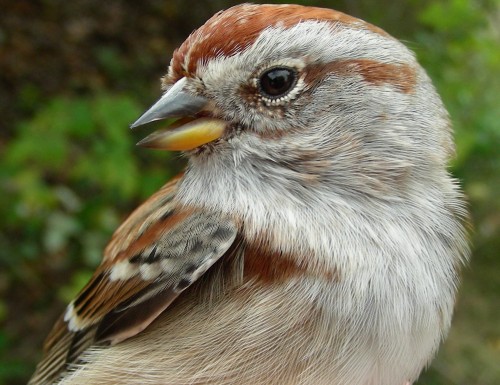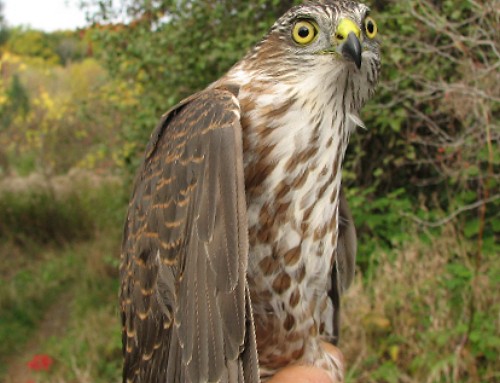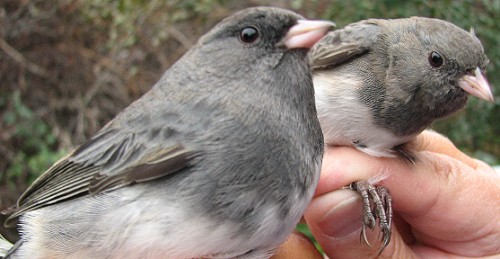|
Week 11: October 10-16, 2007 |
Welcome
to the McGill Bird Observatory weekly report.
Click here for a complete listing of our archives.
Comments or
questions are welcome at "mbo AT migrationresearch.org".
|
PICTURE
OF THE WEEK: |
|

The arrival of American Tree Sparrows in spades this week
signals that winter is
certainly on its way! This little hatch-year was kind
enough to pose for a quick photo
session before release
(Photo by Marie-Anne Hudson)
|
|
|
THIS WEEK |
THIS FALL |
2007 TOTAL |
SITE TOTAL |
|
# birds (and species) banded |
430 (27) |
2435 (75) |
3219 (86) |
12537 (103) |
|
# birds (and species) repeat |
55 (12) |
497 (43) |
612
(47) |
2161 (59) |
|
# birds (and species) return |
1 (1) |
44 (12) |
129 (24) |
329 (29) |
|
# species observed |
55 |
135 |
158 |
191 |
|
# net hours |
348.5 |
4689.5 |
7189.6 |
21212.1 |
|
# birds banded / 100 net hours |
123.4 |
51.8 |
44.6 |
59.0 |
|
|
Note: table does not include nocturnal banding (owls) |
Banders-in-charge: Marie-Anne
Hudson, Barbara Frei
Assistants: Jean Beaudreault, Kristen Brochu, Anne Chen, Shawn
Craik, Diane Demers, Jean Demers, Ross Diamond, Diana Dima, Emilie Dion,
Melanie Drouin, David Fishman, Jeff Harrison, Tiffany Gamelin, Gay
Gruner, Joelle Guellet, Joelle Lapalme, Alyssa Macleod, Barbara MacDuff,
Jennifer MacWilliam, Sarah Marteinson, Mike Mayerhofer, Sophie Mazowita,
Chris Murphy, Annie-Claude Paradis, Leigh Piercey-Brunet, Greg Rand,
Katleen Robert, Brittney Roughan, Brian Schmucker, Anna Solecki,
Stephanie Steeves, Clémence Soulard, Rachel Theoret-Gosselin
Notes: This was another pretty big week, especially
considering we lost net hours to bad weather. Variability in weather is
a big reason for us calculating the "# birds banded per 100 net hours",
as this statistic allows for a more fair comparison between time periods
(and locations). By this standard, week 11 was the busiest so far
this fall, thanks in part to a 139-bird day on Wednesday (which equates
to nearly 200 birds / 100 net hours for that morning).
Thanks
to all who volunteered during this busy week - for the first time in
MBO's history, every volunteer slot was filled for the entire week!
New birds banded include American Tree Sparrow,
which are now present in good number on-site. New birds observed… well,
there weren’t any - so we remain stuck at 134, which is just one more
than the total we had at this time last year; meanwhile the cumulative
total for the year (159) is identical to this point in 2006, showing
remarkable consistency. We’re hoping though that this coming week will
bring some late season migrants in.
The Ruby-crowned Kinglet still reigns supreme with
a large lead this week, maintaining its top spot on the top 10 banded
list. American Robin follow in the second spot yet again, with an
impressive 80 birds banded (which means some very heavy-looking nets
filled with robins). Chickadees and juncos rose to third and fourth
spot respectively, knocking the white-throats into fifth position. The
amount of feeble white-throat singing first thing in the morning has
definitely decreased as well, suggesting they’re well on their way.
Hermit Thrush appeared at number six for the first time this season –
and this doesn’t even reflect how many times we’ve recaptured each one.
These guys are definitely anything but net shy. Their appearance is
right on time, as we banded 14 of them at this time last year. The
white-crowns are still holding steady at number seven, adding further to
their record high season total (75 banded in the last three weeks alone,
compared to a previous high of 50, set last fall). Song Sparrows also
maintained their position in 8th place. The new entries reflect the
shifting avian community, with our “winter sparrows”, the American Tree
and Fox Sparrows, appearing in the last two slots of the list.
|
This week’s
top 10
[last week’s rank in brackets]
|
#
individuals banded |
mean # individuals observed daily |
|
1.
Ruby-crowned Kinglet (145)
[1] |
1.
Canada Goose (800)
[1] |
|
2.
American Robin (80)
[2] |
2.
American Robin (347)
[2] |
|
3.
Black-capped Chickadee (34)
[4] |
3. Red-winged
Blackbird (202)
[5] |
|
4.
Slate-colored Junco (29)
[6] |
4.
American Crow (110)
[4] |
|
5.
White-throated Sparrow (25)
[3] |
5.
European Starling (56)
[6] |
|
6.
Hermit Thrush (21)
[-] |
6.
Ruby-crowned Kinglet (38)
[7] |
|
7.
White-crowned Sparrow (18)
[7] |
7.
White-throated Sparrow (36)
[4] |
|
8.
Song Sparrow (17)
[8] |
8.
Slate-colored Junco (22)
[8] |
|
9.
American Tree Sparrow (10)
[-] |
9.
Common Grackle (20)
[-] |
|
10.
Fox Sparrow (10)
[-] |
10.
Black-capped Chickadee (18)
[-] |
|
The top 10 observed list is fairly similar to last
week’s, with Canada Geese and robins sharing the sky with Red-winged
Blackbirds, American Trees and the occasional flock of European
Starlings. Common Grackles and Black-capped Chickadees are winking in
and out of the top 10 list on a weekly basis now, indicating their
ever-present status on site, but occasionally being pushed out of the
top 10 by more abundant species. Our waterfowl list is pretty sad this
year, as the fields next to us are still green and corn-free. Who knows
what the top ten list will look like next year at this time if they
decide to plant corn… Perhaps we’ll again have an average of 27 Mallards
a day as we did last year?
A
little aside: Marie-Anne and Marcel were very pleased to be able to
attend the biannual Canadian Migration Monitoring Meeting in Slave Lake,
Alberta this past weekend. Our thanks to Environment Canada in Quebec
for contributing some funds toward our travel costs. We were able
to update everyone on MBO’s progress over the past two years (something
we’re very proud of), trade ageing tips, discuss ongoing research
efforts, and spend time with other banders, something we’re always
excited to do. We left the meeting feeling energized and eager to try
new things at MBO. Since we’re so late in the season, these changes
will likely only be seen next spring, all the more reason for you to
keep a few days set aside for us!
|

We know we’ve already put up hawk photos, but we don’t get that
many so we thought we could get away with another one *grin*.
After all, this hatch-year was so photogenic, albeit a little
awkward looking. (Photo by Barbara Frei)

These two Slate-coloured Juncos really show off the differences
in the sexes, the female at the rear and the male at the front.
(Photo by Barbara Frei)
|



